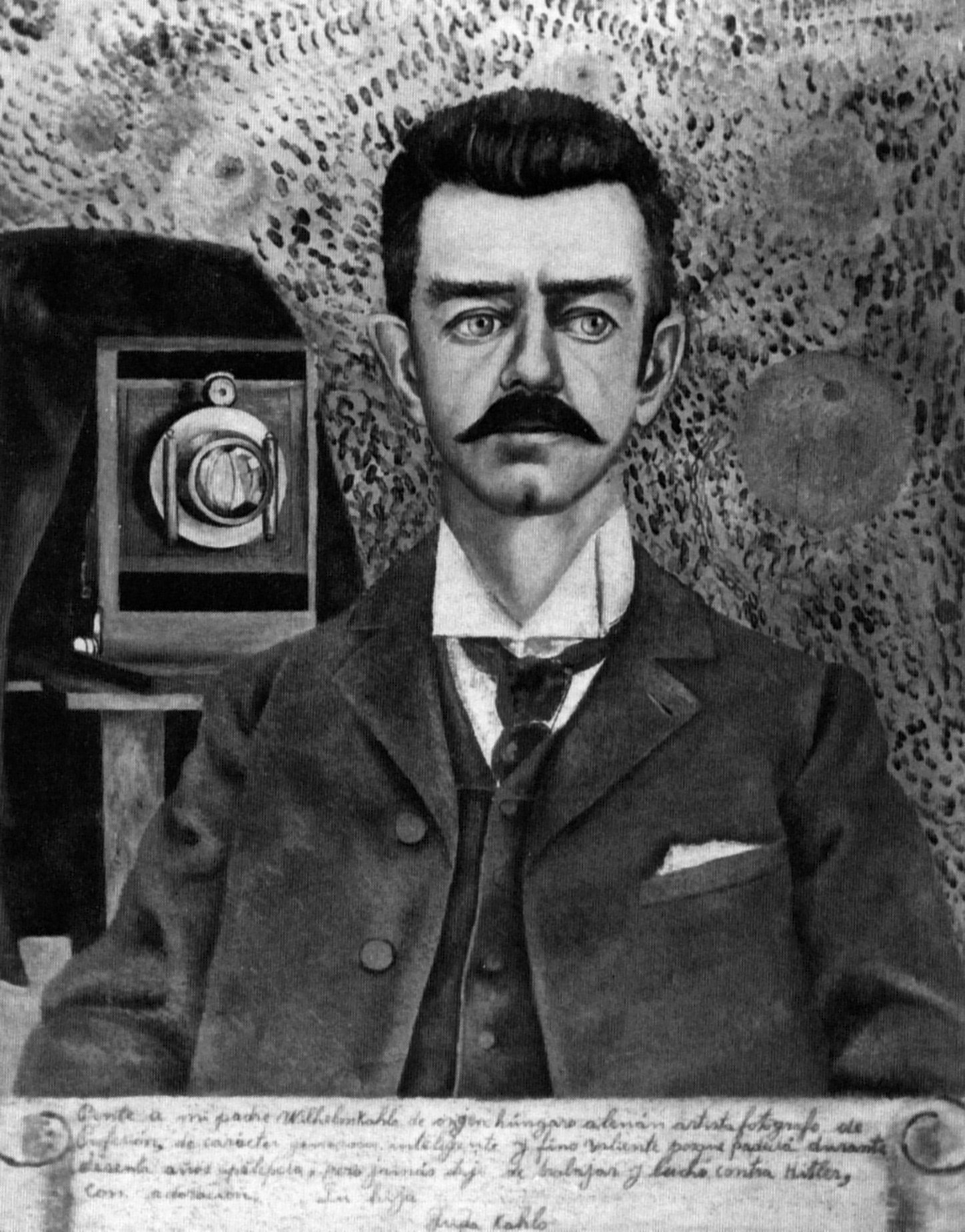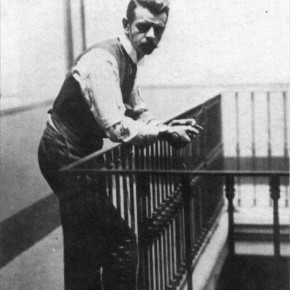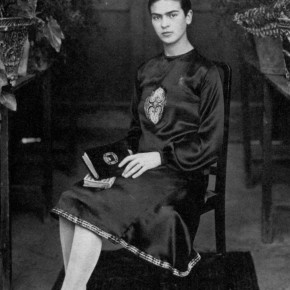Despite the sufferings of ill health, Guillermo Kahlo made pictures that remain a legacy to Mexican art and culture. Like daughter, like father…
Mexican artist Frida Kahlo shared many things with her father; she had his dark eyes and his powerful intellect, and the inspired restiveness of the one was common to the other.
Both daughter and father experienced devastating accidents while young, both suffered from chronic illness afterwards and both were artists.
Frida was Guillermo Kahlo’s third of six daughters, and his favorite. He doted on her as much as his dour and ascetic personality would permit, and especially encouraged his daughter’s vibrant intellectual curiosity. “Frida is the most intelligent of my daughters,” Guillermo once said.
Like many fathers, Guillermo Kahlo hoped to send a child to university – Frida was set on an academic course leading to a career in medicine. But a fateful accident and illness denied Frida the advanced education dreamed of by her father, who himself had had his education cut short after being badly injured in a fall. With good reason, Guillermo said of Frida, “She is the most like me.”
Except for Frida, it seems Guillermo Kahlo had limited interest in children; his preoccupations lay elsewhere. He was a sensitive, sophisticated man, but given to dark moods and long periods of gloomy introspection. He was born in Germany in 1872 to Jewish parents recently emigrated from Romania, and given the name Wilhelm. His father planned that Wilhelm attend university in Nuremberg, but an accident damaged his brain, and left him prey to epileptic seizures for the rest of his life. At age 19 Wilhelm Kahlo, changing his name to Guillermo, boarded a ship bound for Mexico and never returned to Germany.
Kahlo first worked in a glassware store in Mexico City, sold books for a time and finally took a job in a jewelry store owned by a German he had met while crossing the Atlantic. In 1894 he married a Mexican woman who tragically died after giving birth to their second daughter. Kahlo soon married Matilde Calderón, a fellow employee in the jewelry store. She was the oldest of 12 children and the daughter of a photographer from Morelia.
Guillermo Kahlo was then 26 years old, a handsome man of slender build with large brown eyes and an intense gaze. He had thick, brown hair and a moustache with perfectly twirled ends, after the fashion of the day. His presence was aesthetic, “He moved in an elegant way when he walked,” Frida said of her father.
Frida claimed her mother never really loved Guillermo — for Matilde the marriage was opportunistic. Her “romance” with Guillermo was the second with a German. Her first love affair had ended when her German boyfriend committed suicide in her presence.
Matilde persuaded her new husband to follow a career in photography, and in 1901 he opened his own studio above the jewelry store where he and his wife had once worked. Kahlo’s interest was in portrait photography, but he also took on picture assignments for various Mexico City magazines. In 1904 Kahlo’s innate skills with the camera and his fastidious dedication to quality gained him a four-year commission to photograph and catalogue Mexico’s Colonial-period architecture. The job provided Kahlo with a title: First official photographer of Mexico’s cultural patrimony, and, more usefully, an income sufficiently generous to build a new family home. (The “blue house” still stands and serves as the Frida Kahlo Museum in the Mexico City suburb of Coyoacán.) The commission enhanced Kahlo’s already prominent reputation and produced the body of work — still publicly exhibited — for which he is best known today.
The photos illustrated a series of expensive publications produced by the Porfirio Diaz government commemorating the 1910 centenary of Mexico’s independence from Spain. In their time, Kahlo’s photos represented the widest and most systematic collection on the subject ever assembled. Later, more of Kahlo’s work, alongside that of others, appeared as part of a monumental survey of Mexican church photography published in six volumes in the 1920’s.
Kahlo’s photographic style was austere and unaffected, and his manner with his family was similarly uncomplicated. He was a man of fixed schedules and determined habits, often eating alone in the evenings before retreating to his study, where he played Beethoven and Strauss on the piano. He preferred reading to conversation: German philosophers Goethe, Schiller and Schopenhauer topped his reading list. “Philosophy,” Kahlo said, “makes men prudent, and helps them to fulfill their responsibilities.” To relax, Kahlo tried painting. His watercolors were usually of pastoral scenes, or still lifes.
In 1913, at age six, Frida fell ill with polio. She spent nine months in recovery, confined to her room, where her father was a constant visitor. Frida’s biographer Hayden Herrera suggests it was at this time that Guillermo became especially attached to his daughter. He, an epileptic, and the stricken Frida united, “by a shared experience of illness and loneliness.” Later, the role of caregiver went to Frida when, as a young adult, she was sometimes called upon to rescue her father, collapsed in the street by an epileptic seizure. She would provide a whiff of ether to her father with one hand while protecting his scattered camera equipment from thieves with the other.
Guillermo Kahlo shared his fascination with the natural world with his daughter. He also taught her how to use a camera, and how to develop and re-touch photos. But for Frida the work was too finicky. Herrera writes that Frida, “Acknowledged the influence of her father’s professional work on her own only by saying that her paintings were like the photos her father took for calendar illustrations, only instead of painting outer reality she painted the calendars that were inside her head.”
By her father’s arrangement Frida attended the National Preparatory School, one of only 35 girls in an otherwise all-male student body of 2,000. Despite Guillermo’s admonition that his daughter not talk to boys, Frida did, even chatting with the famous Mexican artist Diego Rivera, who was painting a mural in the school at the time. Later, of course, the two married, but not before Guillermo Kahlo admonished, in turn, his daughter´s suitor:
“I see you’re interested in my daughter, eh?,” Rivera recalled Kahlo asking him.
“Yes,” replied Rivera. “Otherwise, I would not be coming…to see her.”
“She’s a devil,” Kahlo said.
“I know it.
“Well, I’ve warned you.”
Frida remembered that her father told Rivera: “Notice that my daughter is a sick person, and all her life she will be sick. She is intelligent but not pretty. Think it over if you want, and if you wish to get married, I give you my permission.” Despite strong reservations from her mother — Rivera was, after all, 20 years older than her daughter, a Communist, and not particularly handsome, Frida’s father seemed accepting of the marriage, as much for practical, financial reasons as any. The costs of Frida’s medical treatments following her tramcar accident had severely strained Guillermo Kahlo’s resources, and the treatments, he knew, would go on for years.
Frida married Diego Rivera on August 21st, 1929.
Guillermo Kahlo died of a heart attack in Mexico City in 1941, at the age of 69. Of her father Frida wrote in her diary: “Although he was a sick man he was an immense example to me of tenderness, of work…and above all of understanding for all my problems.” And to her doctor she wrote: “The death of my father was something terrible for me. You will remember how handsome he was, and how good.”
Frida painted, “Portrait of Don Guillermo Kahlo,” eleven years after his death, and only two years before her own; aware suddenly of the need for a final testament to the man who had meant so much to her. The inscribed scroll below the painting reads: I painted my father, …artist-photographer by profession, in character generous, intelligent and fine, valiant because he suffered for sixty years with epilepsy, but he never stopped working….with adoration. His daughter, Frida Kahlo.
- Guillermo Kahlo, Self-portrait, 1907.
- Frida Kahlo, Portrait of Don Guillermo Kahlo, 1952.
- Frida Kahlo








